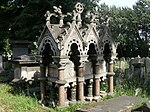North Kensington

North Kensington is an area of west London. It is north of Notting Hill and south of Kensal Green and in the Royal Borough of Kensington and Chelsea. The names North Kensington and Ladbroke Grove describe the same area. North Kensington is where most of the violence of the Notting Hill race riots of 1958 occurred, and where the Notting Hill Carnival started. Ladbroke Grove tube station was called Notting Hill from its opening in 1864 until 1880, and Notting Hill and Ladbroke Grove between then and 1919, when it was renamed Ladbroke Grove (North Kensington). It acquired its current name in 1938. The area was also once served by St. Quintin Park and Wormwood Scrubs railway station, until it closed in 1940.North Kensington was once known for its slum housing, but housing prices have now risen and the area on the whole is considered exclusive and upmarket, although expensive residences are interspersed with lower-income areas like the Lancaster West Estate.
Excerpt from the Wikipedia article North Kensington (License: CC BY-SA 3.0, Authors, Images).North Kensington
Barlby Road, London North Kensington (Royal Borough of Kensington and Chelsea)
Geographical coordinates (GPS) Address Nearby Places Show on map
Geographical coordinates (GPS)
| Latitude | Longitude |
|---|---|
| N 51.523792 ° | E -0.219598 ° |
Address
Shaftesbury Centre
Barlby Road 85
W10 6AZ London, North Kensington (Royal Borough of Kensington and Chelsea)
England, United Kingdom
Open on Google Maps






